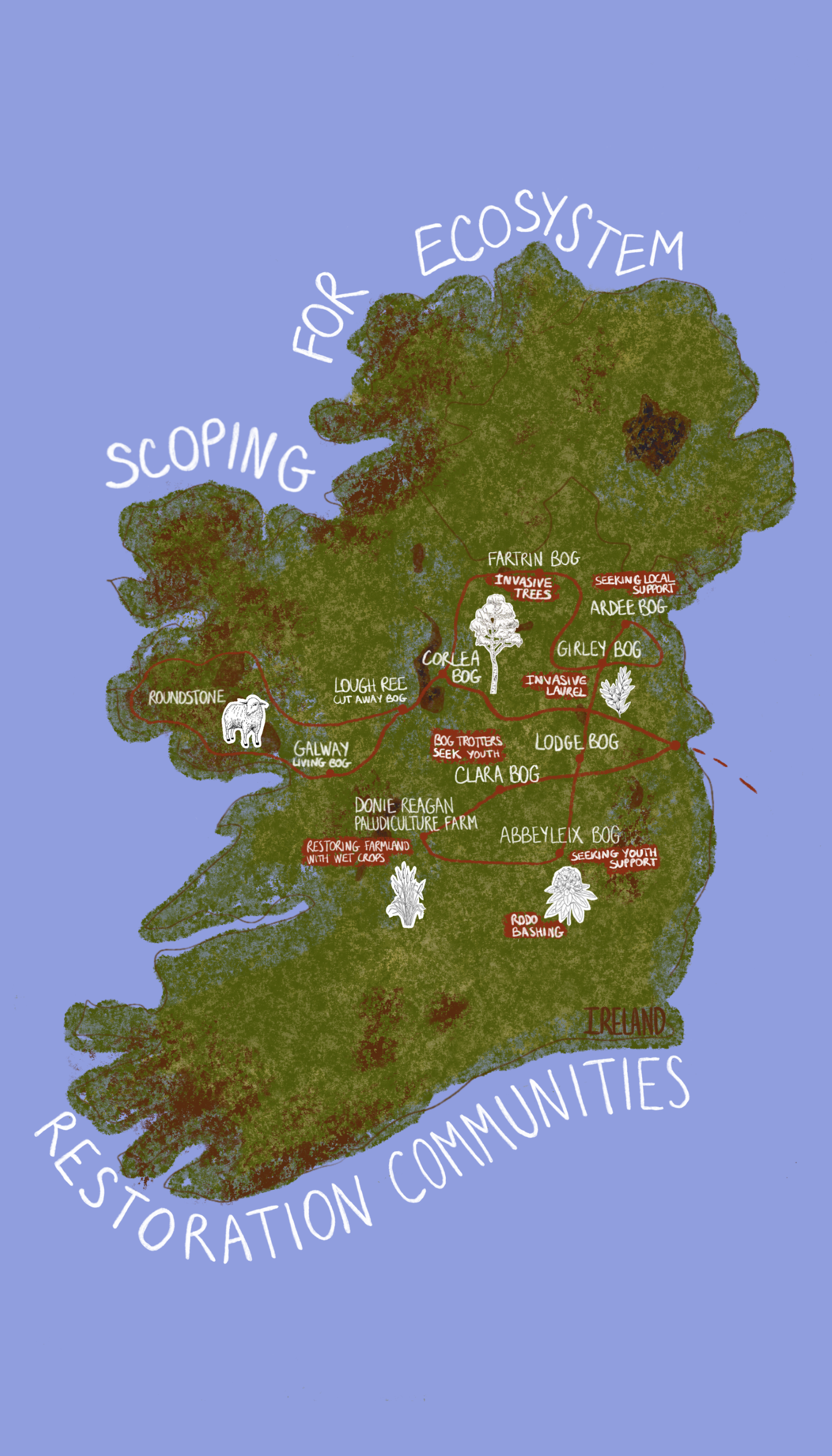Restoration Academy Ireland is on it’s way !
…this is what we know so far.
INTRODUCTION
In June 2025, we travelled through Ireland to meet people and see what potential there is for youth-led restoration camps. With curiosity, we set out to meet community leaders and to better understand what the practical needs are of the site managers.
Along the way, we got the joy of encountering a wide range of bogs, each with its own wet, squidgy character, strange creatures and shy plants. We also got the privilege to meet incredibly generous people from scientific, financial, and community-building backgrounds who shared their time, knowledge, and deep commitment to peatland care.
We also attended the annual Bog Trotters Fest in Clara, where the Bog Bothy was inaugurated, and got to connect with artists and architects who are also working with peatland themes.
The trip left us inspired and full of ideas. We see great potential for building more camps in Ireland, spaces that will promote youth accessibility in hands-on nature restoration, support knowledge exchange between generations, and create opportunities for intercultural exchange.
* Scoping road trip map by Holly Bartley
PLACES & PEOPLE
Corlea Bog: Mary & Mary
Galway Living Bog: Marie & Mora
Roundstone
Lough ree cut away bog: Bridgit & John
Fartrin Bog: Heather & Karina
Girley Bog: Kate Flood
Ardee Bog: Anne & Fiona
Lodge Bog: Nuala
Donie Regan paludiculture farm: Doug & Pedro
Abbeyleix: Garry
Clara Bog: Bernie, Brian & Tommy
Key information
RE-PEAT members: Frankie & Holly
Duration: 10 days
Distance travelled in Ireland: 1500+ Km
Quantity of meetings: 17+ people
Learnings
It is difficult to describe and document everything that we learnt in a short blog post, so for the sake of simplicity we have reduced lots of information into some key learnings that appeared in multiple conversations and seem to be the most important threads.
The fate of peatlands in Ireland is heavily determined by their legal designation, while this is not necessarily representative of the status of the bog on the ground. For example, Ardee Bog is not legally protected, which means that it is threatened by a road construction. This is devastating news as it is clearly such a haven of life; the bog pools were filled with sphagnum, round and long leaf sundews and frog spawn.
The complex and intergenerational land ownership situation of peatlands across the country is a major barrier for restoration, as it means that those who want to take action need to seek the permission of lots of different people, despite not being entirely clear who they are.
There was a repeated and clear desire for more young people to be involved in peatland action across the country, with many of the community group members being older and wanting to pass on their knowledge and passion.
Due to historical degradation, most peatlands now require ongoing maintenance and manual labour to keep them healthy. Actions include, clearing invasive species, transplanting plants, blocking ditches, monitoring species. These can be done with machines, but often require hands-on labour in hard to reach areas.
Community groups are not just faced with practical challenges, but also need to wade through complex legal and political challenges. For example, one of the bogs is being sued by a farmer for wetting and influencing his crops. This means that the volunteer-led community group who look after the site will have to engage with this legal case and ultimately might need to pay more insurance costs as a result.
Overall, there is a need for mutual support between nature protection services, community-driven work and the government. Currently, power dynamics between these actors means that there is a hierarchy of decision-making that seems to disregard local knowledge and initiative.
series on local perspectives : Future wishes for irish bogs
In this first part, Anne and Fiona talk about how they care for peatlands and the need for restoration at Ardee Bog. Doug talks about the importance of providing landowners with wet farming opportunities that allow them to restore peatlands while maintaining a stable source of income.
Here, Kate, Heather, and Garry discuss the importance of protecting peatland biodiversity and engaging youth in restoration efforts.
In this third and final part, Nuala, Tommy, and Bernie address the need for government action and the importance of involving local communities in celebrating peatlands.
So what is next?
We are about to release the Restoration Academy tool pack. This is a document we have been helping to put together over the past months, which gives practical advice and tips for young people and youth workers who want to organise ecosystem restoration camps. This will be turned into a training programme, which we will be sharing in a series of online webinars next year.
Throughout the trip, we were reminded of the value of local rootedness and are keen to work with young people in Ireland and offer these skill shares, trainings and tools so that they can feel confident and excited to get out to their peatlands.
Glossary
In honour of the late Manchán Magan, who was a legendary bog advocate and lover of language, we wanted to share a few words that we picked up along the way that each told a small story.
Meitheal : a collective effort for the greater good of the community
Stuking : stacking the turf
Bin : 6 rows of spread turf
Piezometer : water meter
Dipwells : for measuring the water table
Inter-drumlin hollows : depressions between elongated hills called drumlins
Reading the bog : measuring the water levels
Meadow sweet : a plant that can be used for aspirin
Ribbed moraine : land that forms below the glacial sheet
Bog : means soft in Irish

